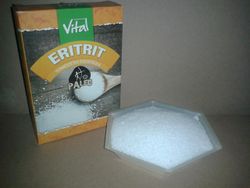Difference between revisions of "Erythritol"
| Line 105: | Line 105: | ||
| OtherFunction = | | OtherFunction = | ||
| OtherFunction_label = | | OtherFunction_label = | ||
| − | | OtherCompounds = [[Glycerol]]<br>[[Sorbitol]]<br>[[Xylitol]] | + | | OtherCompounds = [[Glycerol]]<br>[[Threitol]]<br>[[Sorbitol]]<br>[[Xylitol]] |
}} | }} | ||
}} | }} | ||
Revision as of 20:42, 13 August 2017
 Store-grade erythritol
| |
| Names | |
|---|---|
| IUPAC name
(2R,3S)-butane-1,2,3,4-tetraol
| |
| Properties | |
| C4H10O4 | |
| Molar mass | 122.12 |
| Appearance | White crystalline solid |
| Density | 1.45 g/cm3 |
| Melting point | 121 °C (250 °F; 394 K) |
| Boiling point | 330 °C (626 °F; 603 K) |
| 32 g/100 ml (20 °C) | |
| Hazards | |
| Safety data sheet | ScienceLab |
| Related compounds | |
| Related compounds
|
Glycerol Threitol Sorbitol Xylitol |
| Except where otherwise noted, data are given for materials in their standard state (at 25 °C [77 °F], 100 kPa). | |
| Infobox references | |
Erythritol is a sugar alcohol (or polyol) with the chemical formula C4H10O4. It is used as a sugar substitute, though it is less sweet than sugar. It occurs naturally in some fruit and fermented foods.
Contents
Properties
Chemical
Erythritol will be dehydrated to carbon by strong desiccants, such as conc. sulfuric acid.
Physical
Erythritol is an odorless white crystalline solid, with a slight sweet taste. Erythritol is 60-70% as sweet as table sugar (sucrose). It is soluble in water, but less so in alcohols and acetone.
Availability
Erythritol is available in most hypermarkets and health food stores, and is fairly pure. The price depends on the brand.
Preparation
Erythritol is industrially prepared via the fermentation of glucose from maize-derived starch, using Moniliella pollinis yeast.[1]
Erythritol can be extracted from various plant fruits, such as grapes and pears. However, it's much more economical to simply purchase it from the store.
Projects
- Sugar substitute, either alone or mixed with other sweeteners
- Make erythritol tetranitrate
Handling
Safety
Erythritol is approved as a sugar substitute in many countries. It is slightly less sweet than sucrose, but unlike other sugar alcohols it does not have a laxative effect. Consuming large quantities of erythritol however may cause nausea and stomach rumbling.
Avoid consuming lab-grade erythritol though.
It is not flammable, though it may burn when mixed with an oxidizer.
Storage
Any container with a lid is good: glass jars, plastic boxes, zipper bags, metal cans, etc.
Disposal
No special disposal is required and can be safely poured down the drain or dumped in the ground or trash.